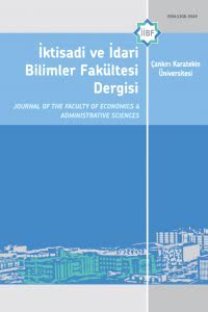The Relationship Between Current Account Balance and Types of Credits: An Application on Selected OECD Countries
The Relationship between Current Account Balance and Types of Credits: An Application on Selected OECD Countries
Current Account Balance, Credits, Panel Data Analysis,
___
- http://stats.bis.org/statx/toc/CRE.html Date Accessed: 12.02.2016.
- http://stats.oecd.org/. Date Accessed: 12.02.2016.
- http://www.data.worldbank.com Date Accessed: 12.02.2016.
- Uygur, E. (2012). Türkiye'de Cari Açık Tartışması. Turkish Economic Association Discussion Paper No. 2012/25.
- Utkulu, U. (2001). Türkiye’de Dış Açıkların Belirleyicileri: Ekonometrik Bir İnceleme. Dokuz Eylül Üniversitesi İ.İ.B.F. Dergisi, 16(2), 113-132.
- Tiryaki, S.T. (2002). Cari İşlemler Hesabına Çeşitli Yaklaşımlar, Sürdürülebilirlik ve Türkiye Örneği. Araştırma Genel Müdürlüğü Çalışma Tebliği No 8, 10.
- Telatar, E. (2011). Türkiye’de Cari Açık Belirleyicileri ve Cari Açık-Krediler İlişkisi. BankacılarDergisi, No. 78, 22-34.
- Tatoglu, F.Y. (2011). The Long and Short Run Effects Between Unemployment and Economic Growth in Europe.Doğuş Üniversitesi Dergisi, 12(1), 99-113.
- Tarı, R., &Calıskan, S. (2005). Kocaeli İlinde Tüketimin Gelir Hipotezlerinin Analizi. Atatürk Üniversitesi İktisadi ve İdari Bilimler Dergisi, 19(2).1-19.
- Seyidoglu, H. (2015). Uluslarası İktisat. 20th Edition, Istanbul. Kurtiş Matbaacılık.
- Sandalcılar, A.R., &Altıner, A. (2014). Türkiye’de Tüketici Kredileri ile Cari İşlemler Açığı Arasındaki Nedensellik İlişkisi.BankacılarDergisi, No 29.
- Rabin, A.A., & Yeager, L.B. (1982). Monetary Approaches to the Balance of Payments and Exchange Rates.International Finance Section, Department of Economics, Princeton University, 148.
- Pettinger,T.(2013). Importance of Current Account Deficit. http://www.economicshelp.org/blog/6701/trade/importance-of-currentaccount-deficit/, Data Accessed: 25.02.2016.
- Pesaran, M.H. (2007). A Simple Panel Unit Root Test in the Presence of CrossSection Dependence.Journal of Applied Econometrics, 22(2), 265-312.
- Pesaran, M.H. (2004). General Diagnostic Tests for Cross Section Dependence in Panels.Cambridge Working Papers in Economics No. 435, University of Cambridge.
- Pesaran, M.H. (2003). Estimation and Inference in Large HeterogenousPanels with Cross Section Dependence.CESifo Working Paper Series No. 869. Available at SSRN: http://ssrn.com/abstract=385123.
- O'Connell, P.G. (1998). The Overvaluation of Purchasing Power Parity.Journal of International Economics, 44(1), 1-19.
- Moon, H.R., &Perron B. (2004).Testing for A Unit Root in Panels with Dynamic Factors. Journal of Econometrics, 122(1), 81-126.
- Maddala, G.S.,&Shaowen W. (1999).A Comparative Study of Unit Root Tests with Panel Data and A New Simple Test.Oxford Bulletin of Economics and Statistics61.S1, 631-652.
- Loayza, N., Chong, A., &Calderon, C.A. (1999). Determinants of Current Account Deficits in Developing Countries.World Bank Policy Research Working Paper No. 2398.
- Levin, A., Chien-Fu L., &Chu, C.J. (2002).Unit Root Tests in Panel Data: Asymptotic and Finite-Sample Properties. Journal of Econometrics, 108(1), 1-24.
- Im, K.S.,Pesaran, M.H.,& Shin Y. (2003). Testing For Unit Roots in Heterogeneous Panels. Journal of Econometrics, 115(1), 53-74.
- Kılıc, C. (2015). Tüketici Kredileri ve Cari Açık Arasındaki İlişki: Türkiye Örneği. Atatürk Üniversitesi İktisadi ve İdari Bilimler Dergisi, 29(2).407420.
- Hausman, J.A. (1978). Specification Tests in Econometrics.Econometrica: Journal of the Econometric Society, 1251-1271.
- Hadri, K. (2000). Testing for Stationary in Heterogeneous Panel Data.The Econometrics Journal, 3(2), 148-16.
- Gocer, I., Mercan, M.,&Peker, O. (2013). Kredi Hacmi Artışının Cari Açığa Etkisi: Çoklu Yapısa Kırılmalı Eşbütünleşme Analizi. Ekonometri ve İstatistik e-Dergisi,18, 1-17.
- Gacener A., A., &Saygılı, F.(2014).Türkiye'de Kredi Hacmi ve Cari Açık ilişkisi Üzerine Bir İnceleme. Business & Economics Research Journal, 5(4), 129141.
- European Commission.(2012). Current Account Surpluses in the EU.European Economy, No.9/2012, http://dx.doi.org/10.2765/19685.
- Erdem, E., Gulbahar, U., &Bulut, U.(2014).Impact of Domestic Credits on the Current Account Balance: A Panel ARDL Analysis for 15 OECD Countries. Актуальніпроблемиекономіки 1, 408-416.
- Ekinci, M.F., Erdem F.P., &Kilinc, Z. (2015).Credit Growth, Current Account and Financial Depth. Applied Economics, 47(17), 1809-1821.
- Duasa, J.(2004). The Malaysian Balance of Payments: Keynesian Approach Versus Monetary Approach.Society for Computational Economics No. 26.
- Choi, I. (2001). Unit Root Tests for Panel Data. Journal of International Money and Finance, 20(2), 249-272.
- Cınar,S. (2016). Enviroment, Society and Economic Growth.http://barcelona2016.econworld.org/programme_papers/papers/Cina r_Environment.pdf. (Data Accessed: 11.3.2016).
- Buyukkarabacak, B.,& Krause, S. (2005). Studying the Effects of Household and Firm Credit on the Trade Balance: The Allocation of Funds Matters.Department of Economics, Emory University (Atlanta) No. 0510.
- Breitung, J,& Das, S. (2005). Panel Unit Root Tests under Cross-Sectional Dependence. Statistica Neerlandica, 59(4), 414-433.
- Breitung, J. (2000). Nonstationary Panels, Panel Cointegration, and Dynamic Panels.Adv. Econ, 15(2), 161-78.
- Boamah, D.O., Jackman, M., &Mamingi, N. (2011).Credit Growth and the External Current Account in Barbados. Journal of Eastern Caribbean Studies. 36(3), 16-39.
- Bai, J., & Serena, N. (2004).A Panic Attack on Unit Roots and Cointegration.Econometrica, 72(4),1127-1177.
- Aristovnik, A. (2008). Short-Term Determinants of Current Account Deficits: Evidence from Eastern Europe and the Former Soviet Union. Eastern European Economics, 46(1), 24-42.
- Angeles, L. (2015). Credit Expansion and the Economy, Applied Economics Letters, 22(13),1-9.
- Altintas, H. & Mercan M. (2015). AR-GE Harcamaları ve Ekonomik Büyüme İlişkisi: OECD Ülkeleri Üzerine Yatay Kesit Bağımlılığı Altında Panel Eşbütünleşme Analizi, Ankara Üniversitesi SBF Dergisi, 70(2).
- Aliogulları, Z.H., Baskaya, Y.S., Bulut, Y.E., &Kılınc, M. (2015). Türkiye’de Tüketici ve Ticari Kredilerin Cari Açıkla İlişkisi. Research and Monetary Policy Department, Central Bank of the Republic of Turkey, No.2015-19.
- ISSN: 1308-5549
- Yayın Aralığı: 4
- Başlangıç: 2011
- Yayıncı: Çankırı Karatekin Üniversitesi
KOBİ’lere Sağlanan Teşvikler ve KOBİ’lerin Vergi Algısı İlişkisi: Afyonkarahisar Örneği
Rabia Tuğba EĞMİR, Gülsüm GÜRLER HAZMAN
Menkul Kıymet Borsası ile Reel Sektör İlişkisi: Güncel Bir Yaklaşımla Panel Veri Analizi
Nihat IŞIK, Suat Serhat YILMAZ, Efe Can KILINÇ
Finansal Okuryazarlık ve Tasarruf Davranışları: Kamu Çalışanları Üzerine Bir İnceleme
Mustafa Kemal DEĞER, Muharrem Akın DOĞANAY
Orta Gelir Tuzağından Çıkış İçin Yeni Bir Strateji: Küresel Keynesyencilik
Rekabet ve Etkinlik: Avrupa Birliği Bankacılık Endüstrisi Üzerine Bir Uygulama
